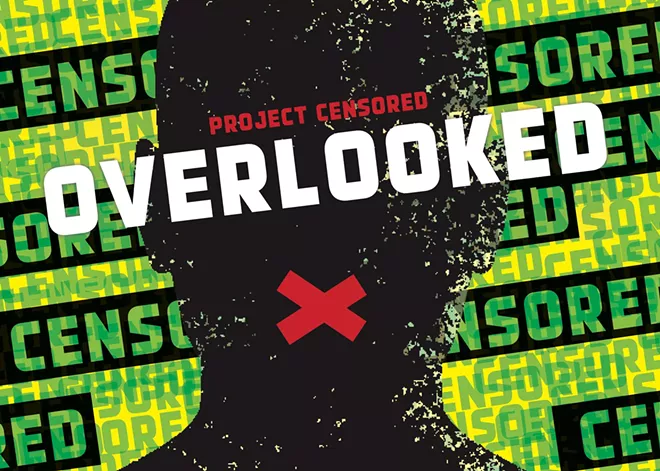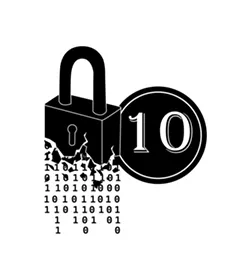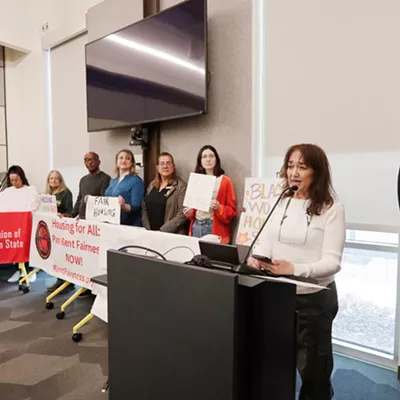With any "Top 10" list, there's a natural tendency to look first at number one, and neither I nor Project Censored would discourage you from doing that when it comes to their annual list of the top censored stories of the year. This year, the top story is about workplace deaths and injuries — with striking racial disparities. Sensationalized deaths and injuries make the news all the time, but workplace deaths and injuries (nearly 6,000 and 2.8 million, respectively in a year) are another matter altogether. They're a non-story, even when advocates strive to shine a light on them.
But this pattern of what's deemed newsworthy and what isn't leads to a deep point. Project Censored Associate Director Andy Lee Roth writes that "readers can only appreciate the full significance of the project's annual listing of important but underreported stories by stepping back to perceive deeper, less obvious patterns of omission in corporate news coverage." And I couldn't agree more. The patterns of what's being blocked out of the public conversation are the clearest way of seeing the censoring process at work — the process that Project Censored founder Carl Jensen described as "the suppression of information, whether purposeful or not, by any method ... that prevents the public from fully knowing what is happening in its society."
It's not just that somehow all the news assignment editors in America overlooked this or that story. Where there are patterns of omission so consistently, year after year, they can only be explained by systemic biases rooted in the interests of particularly powerful special interests. One can also find intersecting patterns within individual stories. The above description of the top story is an example: race, class, region, citizenship status and more are all involved.
At a big-picture level, there are three stories dealing with cyber issues and four that are each clearly dealing with the environment, corporate misconduct, harm to consumers and race. Or perhaps I should say seven dealing with race, the more I think about what "clearly" means.
For example, story number seven, about military personnel targeting Gen Z recruits with lurid social media tactics, clearly involves cyber deception of consumers with the aim of luring them into a dangerous workplace from which they cannot simply resign once they realize they've been lied to or conned. In addition to cyber, consumer and workplace harm, the target audience and resulting recruits are undoubtedly disproportionately non-white, though that's not explicitly dwelt on.
I'm dwelling on race because it's important, but also because it's easily highlighted in this context. But there are other hidden connections to be found in these stories. The point is, as you do more than just simply read these stories — as you reflect on them, on why they're censored, whose stories they are, what harms are being suffered, whose humanity is being denied — you will find yourself seeing the world more from the point of view of those being excluded from the news, and from the point of view that you're interconnected with them at the least, if not one of them.
RACIAL DISPARITY OF WORKPLACE DEATHS
Working in America is becoming more dangerous, especially for minorities, according to recent studies reported on by Truthout and Peoples Dispatch, while the same isn't true for other developed nations.Workplace fatalities increased 5.7% in the 2021-22 period covered by the Bureau of Labor Statistics' Census of Fatal Occupational Injuries, Tyler Walicek reported for Truthout. "Nearly 6,000 U.S. workers died on the job," he wrote — a 10-year high — while "a startling total of 2.8 million were injured or sickened," according to another report.
The racial disparities were sharp. The average workplace death rate was 3.7 deaths per 100,000 full-time workers, but it was 24.3% higher (4.6 deaths) for Latiné workers and 13.5% higher (4.2 deaths) for Black workers. The majority of Latiné deaths were of foreign-born workers, and 40% of those were in construction.
Transportation incidents were the highest cause of fatalities within both groups. Violence and other injuries by persons or animals were second highest for Black workers, while for Hispanic or Latiné workers it was falls, slips or trips. Black people and women were particularly likely to be homicide victims. Black people represented 13.4% of all fatalities, but 33.4% of homicide fatalities. Women represented 8.1% of all fatalities, but 15.3% of homicide fatalities.
The non-fatal injury rate for service workers in the South, particularly workers of color, is also alarmingly high. A March 2023 poll of 347 workers, most of whom were Black, "found that a shocking 87% were injured on the job in the last year," Peoples Dispatch reported. In addition, "More than half of survey respondents reported observing serious health and safety standard [violations] at work," and "most workers worried about their personal safety on the job, most believe that their employer prioritizes profit over safety, most do not raise safety issues for fear of retaliation, and the vast majority (72%) believe that their employer's attitude 'places customer satisfaction above worker safety.'"
Workplace fatality rates in the U.S. exceeded those in the U.K., Canada, Australia and much of Europe, according to a 2021 assessment by the consulting firm Arinite Health and Safety, Walicek reported.
While independent nonprofits like DC Report have consistently paid more attention to the issue, two corporate outlets, the Associated Press and Bloomberg Law, also touched on the topic yet neither addressed the issue of racial disparities.
TRAPPED BY CLIMATE DEBT
Low-income countries that contributed virtually nothing to the climate crisis are caught in a pattern described as a "climate debt trap" in a September 2023 World Resources Institute report, authored by Natalia Alayza, Valerie Laxton and Carolyn Neunuebel.
"After years of pandemic, a global recession, and intensifying droughts, floods and other climate change impacts, many developing countries are operating on increasingly tight budgets and at risk of defaulting on loans," they wrote. "High-interest rates, short repayment periods, and...the coexistence of multiple crises (like a pandemic paired with natural disasters) can all make it difficult for governments to meet their debt servicing obligations."
Global standards for climate resilience require immense national budgets. Developing countries borrow from international creditors, and as debt piles up, governments are unable to pay for essential needs, including public health programs, food security and climate protections.
In fact, The Guardian ran a story describing how global south nations are "forced to invest in fossil fuel projects to repay debts," a process critics have characterized as a "new form of colonialism." They cited a report from anti-debt campaigners Debt Justice and partners, which found that "the debt owed by global south countries has increased by 150% since 2011 and 54 countries are in a debt crisis, having to spend five times more on repayments than on addressing the climate crisis."
While a loss and damage fund to assist developing countries that are particularly vulnerable to the adverse effects of climate change was established at the 2022 Climate Summit, its current commitments ($800 million) fall far short of the $100 billion more each year by 2030 that the 14 developing countries on the fund's board have argued for. Some estimates place the figure much higher, "at around $400 billion," according to a Euronews story last June.
The climate debt trap has received limited news coverage. Aside from The Guardian, independent news coverage has been limited to outlets that specialize in climate news.
FRESHWATER SUPPLY THREATENED
Sea-level rise is an easy-to-grasp consequence of global warming, but the most immediate threat it poses — saltwater intrusion into freshwater systems — has only received sporadic localized treatment in the corporate press.In fall 2023, saltwater traveling from the Gulf of Mexico up the Mississippi River infiltrated the freshwater systems of the delta region, contaminating drinking and agricultural water supplies as well as inland ecosystems. The crisis prompted a scramble to supply potable water to the region and motivated local and federal officials to issue emergency declarations.
While outlets like Time, CNN and CBS News covered the intrusion at the time, they focused almost exclusively on the threat to coastal Louisiana. Yet, a pair of articles published in October 2023 by Delaney Nolan for The Guardian and hydrogeologist Holly Michael for The Conversation highlighted the escalating threat of saltwater intrusion across the U.S. and beyond.
"Deep below our feet, along every coast, runs the salt line: the zone where fresh inland water meets salty seawater," Nolan wrote. "That line naturally shifts back and forth all the time, and weather events like floods and storms can push it further out. But rising seas are gradually drawing the salt line in. In Miami, the salt line is creeping inland by about 330 feet per year."
Seawater intrusion into groundwater is happening all over the world, but perhaps the most threatened places are communities on low-lying islands such as the Marshall Islands, which are predicted to be uninhabitable by the end of the century, Michael wrote.
Here in the U.S., "experts said the threat was widespread, but they were especially concerned about cities in Louisiana, Florida, the Northeast and California," Nolan reported.
"When seawater moves inland, the salt it contains can wreak havoc on farmlands, ecosystems, lives and livelihoods," Michael wrote. "Drinking water that contains even 2% seawater can increase blood pressure and stress kidneys. If saltwater gets into supply lines, it can corrode pipes and produce toxic disinfection byproducts in water treatment plants. Seawater intrusion reduces the life span of roads, bridges and other infrastructure."
While gas stoves erupted as a culture war issue in 2023, reporting by Vox and NPR (in partnership with the Climate Investigations Center) revealed a multi-decade campaign by the natural gas industry to discredit evidence of harm, thwart regulation and promote the use of gas stoves.
HIDDEN RISKS OF GAS STOVES
In a series of articles for Vox, environmental journalist Rebecca Leber documented how the gas utility industry used strategies previously employed by the tobacco industry to avoid regulation and undermine scientific evidence establishing the harmful health and climate effects of gas stoves."The basic scientific understanding of why gas stoves are a problem for health and the climate is on solid footing," she reported. "It's also common sense. When you have a fire in the house, you need somewhere for all that smoke to go. Combust natural gas, and it's not just smoke you need to worry about. There are dozens of other pollutants, including the greenhouse gas methane, that also fill the air."
The concerns aren't new. "Even in the early 1900s, the natural gas industry knew it had a problem with the gas stove," Leber recounts. It was cleaner than coal or wood — its main competition at the time, "but new competition was on the horizon from electric stoves. Forty years ago, the federal government seemed to be on the brink of regulating the gas stove," she wrote. "Everything was on the table, from an outright ban to a modification of the Clean Air Act to address indoor air pollution." The gas industry fought back with a successful multiprong attack, that's being mounted again today, and "some of the defenders of the gas stove are the same consultants who have defended tobacco and chemicals industries in litigation over health problems."
Documents obtained by NPR and Climate Investigations Center tell a similar story. The industry "focused on convincing consumers and regulators that cooking with gas is as risk-free as cooking with electricity," they reported.
By covering gas stoves as a culture war controversy, corporate media have ignored the outsize role of the natural gas industry in influencing science, regulation and consumer choice. Instead, they've focused on individual actions, local moves to phase out gas hookups for new buildings, and right-wing culture war opposition to improving home appliance safety and efficiency, including the GOP House-passed "Hands Off Our Home Appliances Act."
ABORTION SERVICES CENSORED
On the first national Election Day after Dobbs, PlanC, a nonprofit that provides information about access to abortion medication, posted a TikTok video encouraging people to vote to protect reproductive rights. Almost immediately, its account was suddenly banned. This was but one example of a worldwide cross-platform pattern."Access to online information about abortion is increasingly under threat both in the United States and around the world," the Women's Media Center, or WMC, reported in November 2023. "Both domestic and international reproductive health rights and justice organizations have reported facing censorship of their websites on social media platforms including Instagram, Facebook, and TikTok as well as on Google."
The governments of South Korea, Turkey and Spain have also blocked the website of Women on Web, which provides online abortion services and information in over 200 countries.
Women's rights advocacy groups are calling the Supreme Court's overturning of Roe v. Wade the catalyst for the suppression of reproductive health information on social media. Hashtags for #mifepristone and #misoprostol, two drugs used in medical abortions, were hidden on Instagram after the Dobbs decision, the WMC reported.
Within weeks of the decision, U.S. Sens. Elizabeth Warren, D-Mass., and Amy Klobuchar, D-Minn., wrote to Meta, Ars Technica reported, questioning what the company was doing to stop abortion censorship on their platforms.
There are similar censorship problems with Meta and Google worldwide, according to a March 2024 report by the Center for Countering Digital Hate and MSI Reproductive Choices, which provides contraception and abortion services in 37 countries. This sparked a Guardian article by Weronika Strzyzynska. "In Africa, Facebook is the go-to place for reproductive health information for many women," MSI's global marketing manager, Whitney Chinogwenya, told the Guardian. "We deal with everything from menopause to menstruation, but we find that all our content is censored. Meta viewed reproductive health content through 'an American lens,' applying socially conservative U.S. values to posts published in countries with progressive policies such as South Africa, where abortion on request is legal in the first 20 weeks of pregnancy."
Abortion disinformation is also a threat — particularly the promotion of "crisis pregnancy centers" or CPCs, which masquerade as reproductive health care clinics but discourage rather than provide abortion services. The WMC reported that "CPCs spent over $10 million on Google Search ads for their clinics over the past two years." Google claimed to have "removed particular ads, but they did not take action on the systemic issues with fake clinic ads."
Women's rights organizations and reproductive health advocates have been forced to squander scarce resources fighting this sort of disinformation, which has gotten some coverage, but as of June 2024, corporate coverage of abortion censorship has been limited. Independent reporting from Jezebel and Reproaction via Medium have done more to draw attention to this issue.
GLOBAL FOREST PROTECTION RISKS
The UN's goal to end deforestation by 2030 is unlikely to be met, according to the 2023 annual Forest Declaration Assessment, Olivia Rosane reported for Common Dreams in October 2023. The goal was announced to great fanfare at the 2021 UN summit in Glasgow, but the failure of follow-through has received almost no notice.The same month, the World Wildlife Fund issued its first Forest Pathways Report, in which it warned: "The two largest tropical forests are at risk of reaching tipping points. This would release billions of tonnes of carbon and have devastating consequences for the millions of people who depend on the stability of their ecosystems. It would also have a global impact on our climate and catastrophic effects on biodiversity."
The problem is money. "We are investing in activities that are harmful for forests at far higher rates than we are investing in activities that are beneficial for forests," said the report's coordinator, Erin Matson. To meet the UN's 2030 goal would require $460 billion annually, but only $2.2 billion is being invested. Meanwhile, more than 100 times as much public finance is "committed to activities that have the potential to drive deforestation or forest degradation."
While the overall picture is dark, not all countries are failing. "Well over 50 countries are on track to eliminate deforestation within their borders by 2030," the report noted.
As the report's lead author, Mary Gagen, noted in an article by The Conversation, "Global forest loss in 2022 was 6.6 million hectares, an area about the size of Ireland. That's 21% more than the amount that would keep us on track to meet the target of zero deforestation by 2030."
Corporate media in the U.S. largely ignored both reports. One story in the Washington Post discussed the subject, but made no direct reference to either report.
MILITARY TARGETS GEN Z WITH LURID TACTICS
"If the military was a great, honorable profession, then they wouldn't need to spend $6 billion a year bribing people to join," journalist and veteran Rosa del Duca wrote. Nonetheless, 2022 was the worst year for recruitment since 1973, when the draft was abolished. That's the background to the story Alan MacLeod reported for MintPress News about the military, "using e-girls to recruit Gen Z into service."While MacLeod also covers the Army sponsoring YouTube stars — male and female — to "join" for a day as part of its social media efforts, his main subject is self-described Army psychological operations specialist Hailey Lujan, whose online videos feature "sexually suggestive content alongside subtle (and sometimes not-so-subtle) calls to join up," he writes. "The 21-year-old makes content extolling the fun of Army life to her 731,000 TikTok followers. 'Don't go to college, become a farmer or a soldier instead,' she instructs viewers in a recent video. 'Just some advice for the younger people: If you're not doing school, it's OK. I dropped out of college. And I'm doing great,' she adds."
Lujan's videos seemingly violate the code of conduct of the image-conscious U.S. military, and it's unclear what role the military has in producing her content. But that ambiguity is part of the allure.
"There are many active duty service members with large social media followings, but what makes Lujan stand out is her offbeat, Gen-Z style humor and how she leans into the idea that she is a military propaganda operation," Macleod writes. "With videos titled 'My handlers made me post this', 'Not endorsed by the DoD : 3' or 'most wholesome fedpost,' she revels in layers of irony and appears to enjoy the whole 'am I or aren't I' question that people in her replies and mentions constantly debate."
"I can't believe she's getting away with posting some of this stuff," said del Duca in an interview with MintPress News. "Everyone learns in boot camp that when you are in uniform, you cannot act unprofessionally, or you get in deep trouble." The Defense Department didn't respond when MacLeod reached out for clarification.
Lujan isn't the only online military influencer, but her overt use of her sensuality and her constant encouragement of her followers to enlist makes her noteworthy.
The branches of the U.S. military are no stranger to partnerships with entertainment giants (like the NFL) that traditionally engage viewers from all walks of life. But this new attempt to appeal to niche youth audiences has not been scrutinized.
"It is now well-established (if not well-known) that the Department of Defense also fields a giant clandestine army of at least 60,000 people whose job it is to influence public opinion, the majority doing so from their keyboards," MacLeod reported, adding that a 2021 Newsweek exposé "warned that this troll army was likely breaking both domestic and international law."
As of May 2024, Project Censored reported no new coverage on this specific instance that appears to take such lawbreaking to a new level.
NEW FEDERAL RULE LIMITS TRANSCRIPT WITHHOLDING
More than 6 million students have "stranded credits" due to the practice of colleges and universities withholding students' transcripts to force them to repay loan debts. But a new federal Department of Education regulation will make withholding more difficult, Sarah Butrymowicz and Meredith Kolodner reported for The Hechinger Report in December 2023.Transcript withholding "has become a growing worry for state and federal regulators," they wrote. "Critics say that it makes it harder for students to earn a degree or get a job, which would allow them to earn enough to pay back their debts. But the system of oversight is patchwork; no single federal agency bans it, state rules vary, and there are significant challenges with monitoring the practice."
The rule was part of a package also intended to "strengthen the U.S. Department of Education's ability to protect students and taxpayers from the negative effects of sudden college closures," the DOE said in a press release. It went into effect in July 2024. Specifically, it prevents withholding a transcript for terms in which a student received federal financial aid and paid off the balance for the term.
As Katherine Knott reported for Inside Higher Education ... the new policy is part of a set of regulations intended to enhance the DOE's oversight of institutions by providing additional tools to hold all colleges accountable. But these protections do not apply to institutions that accept no federal student aid, including many for-profit colleges.
The Consumer Financial Protection Bureau is also investigating transcript withholding, which it has deemed abusive because the practice is "designed to gain leverage over borrowers and coerce them into making payments."
There has been limited corporate news coverage on the issue. When the rule package was announced in October 2023, the Washington Post published a substantive report emphasizing the protections from sudden college closures, but only briefly noted transcript withholding. Early reporting in U.S. News & World Report and the New York Times covered the issue, but the government's response has gone virtually unnoticed.
ACQUITTED-CONDUCT SENTENCING CHALLENGED
You might be surprised — even shocked — to learn that federal judges can determine defendants' sentences based on charges they've been acquitted of by a jury. But in April 2024, the United States Sentencing Commission (USSC), a bipartisan panel that creates guidelines for the federal judiciary, voted to end the practice as it applies to "calculating a sentence range under the federal guidelines."The change will significantly limit federal judges' use of acquitted-conduct sentencing, as the legal news service Law360 and Reason magazine reported. The commission voted unanimously "to prohibit judges from using acquitted conduct to increase the sentences of defendants who receive mixed verdicts at trial" but was "divided" on whether its proposal ought to apply retroactively, Stewart Bishop reported for Law360. There are still narrow circumstances where such conduct can be considered, such as if it underlies a charge the defendant is found guilty of as well as the acquitted crime.
Acquitted conduct had been allowed under a lower standard, if the judge found the charges more likely truth than not, rather than the jury's standard of "beyond a reasonable doubt." But now, "not guilty means not guilty," chair of the USSC, U.S. District Judge Carlton W. Reeves said in a press release.
There's been little corporate media coverage. Project Censored cited one story in Bloomberg Law, but nothing in the New York Times nor the Washington Post as of June 2024.
AI'S SERIOUS SECURITY CONCERNS
Generative artificial intelligence (AI) apps carry considerable risks, some poorly understood, which can result in exposing sensitive data and opening up organizations to attacks from bad actors. In response, both government and businesses have taken steps to limit or even block AI access to data.Congress only permits lawmakers and staff to access ChatGPT Plus, a paid version of the app with enhanced privacy features, and forbids them from using other AI apps or pasting blocks of text that have not already been made public into the program. A follow-up regulation banned the use of Microsoft's Copilot AI on government-issued devices. The National Archives and Records Administration is even more restrictive. In May 2024 it completely prohibited employees from using ChatGPT at work and blocked all access to the app on agency computers. What's more, "Samsung decided to ban its employees' use of generative AI apps (and develop its own AI application) in May 2023 after some users accidentally leaked sensitive data via ChatGPT," Priya Singh reported for Business Today in April 2024.
Programs such as ChatGPT and Copilot are built by a training process that collects and organizes data which can be regurgitated in response to just a snippet of text. They are then "aligned" with an added layer of training to produce helpful output, which is what ordinary users normally see.
But something as simple as asking ChatGPT to repeat a word endlessly can cause it to break alignment and reveal potentially sensitive data, Tiernan Ray reported for ZDNet in December 2023. Researchers from Google's DeepMind AI research lab found that ChatGPT "could also be manipulated to reproduce individuals' names, phone numbers, and addresses, which is a violation of privacy with potentially serious consequences," he reported. "With our limited budget of $200 USD, we extracted over 10,000 unique examples," the researchers wrote. "However, an adversary who spends more money to query the ChatGPT API could likely extract far more data."
While training data itself can hold sensitive information, users are constantly adding new data that can also be exposed. In another article for tech news site ZDNet, Eileen Yu cited a survey of some 11,500 employees in the U.S., Europe and Asia, which found that "57% of employees used public generative AI tools in the office at least once weekly, and that "31% of employees polled admitted entering sensitive information such as addresses and banking details for customers, confidential HR data, and proprietary company information into publicly accessible AI programs."
Corporate media have given a lot of breathless coverage to the existential threat to humanity allegedly posed by AI. Yet these outlets have been far less attentive to AI apps' documented data security risks and vulnerability to hackers, issues that have been given exhaustive coverage by smaller, tech-focused news outlets. ♦
Paul Rosenberg is a California-based writer senior editor for Random Lengths News, and a columnist for Al Jazeera English and Salon.































